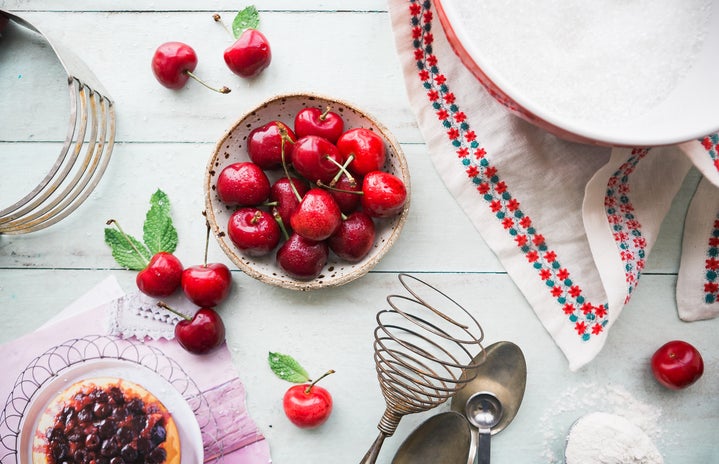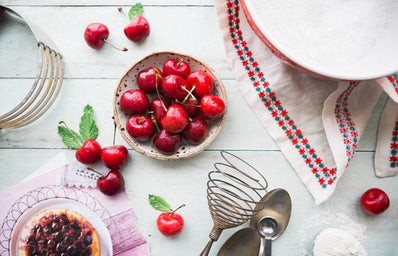Much like that frat star known to take his shirt off at every party or that professor who is a notoriously harsh grader, foods get reputations. But while these reputations may be well known and generally accepted, they’re unfortunately not always true. It’s hard for a greasy slice of pepperoni pizza or a brownie sundae to be mistaken for a nutritious pick, but some foods actually do masquerade as healthy options when, in reality, they’re packed with an excessive amount of fat, calories, sugar, or sodium and lack the health benefits they claim. We talked to expert Susan Holmberg, a nutritionist and behavior modification clinician, and did the detective work to debunk these foods so that you won’t unknowingly do damage to your diet and can make better choices instead.
1. Fruit-flavored yogurt
Fruit plus yogurt equals healthy, right? Not necessarily. Yogurt with added sugar is the top sneakily unhealthy foods that Holmberg lists. Though many fruit-flavored yogurts boast that they are low-fat or fat-free or low in calories, almost all of the calories they do have are from sugar, rather than something filling like protein or fiber.
A small 6 oz container may have up to 20 grams of sugar—and a Hershey’s chocolate bar has 24 grams. What’s worse is that the jelly-like fruit at the top or bottom, which Holmberg refers to as “junk,” is typically more artificial flavoring than it is fruit.
To avoid a sugar bomb, stick to plain yogurt and mix real fruit (berries, bananas) into it.
Opting for plain Greek yogurt over regular will give you more protein to keep you satisfied, and swirling in a bit of honey can sweeten it up.
2. Pre-packaged salads
Salads have a great rep as being the best option on any menu, but it turns out that not all salads are created equal. According to Daily Mail, “some supermarket salads contain more fat and calories than a Big Mac and fries.” Pre-packaged salads provide on-the-go convenience, but they often are less healthy than you may think due to the pile of cheese, croutons, salt-laden deli meats, and creamy dressings on top.
Avoid making an unhealthy choice by checking the nutrition label—a good ballpark is around 300-500 calories. Keep in mind that a Big Mac has 29 grams of fat, so if the salad in question has a comparable fat content, then nix it… or go for a Big Mac instead. Your best bet is to hit up the salad bar rather than the pre-packaged aisle to ensure freshness and control what goes into your salad. If you are stuck with a pre-packaged salad, take out the cheese, candied nuts or sugar coated dried fruit, and croutons and go easy on the salad dressing to make it healthier.
3. Granola
With the rep of being a very natural food, granola is a breakfast or snack staple for many collegiettes. But what keeps those oats clustered together is often unhealthy oils and syrups that bring a lot of extra fat and calories to your bowl. From artificial sweeteners and flavors, to high-fructose corn syrup and sugar, a half cup of granola typically contains anywhere from 280-500 calories!
“Freshmen year my friends and I would always eat the granola in the dining hall for breakfast,” says Tara, a sophomore at the University of Michigan. “Then, the calories of all the foods were posted in the dining halls and online, and we were shocked to find out how many calories we were consuming…. a half cup has a whopping 512 calories and we were probably eating more than that every morning!”
If this is the worst news you’ve ever heard, wipe your tears because there are a few ways you can enjoy granola healthfully. First, look for brands that use natural sweeteners in place of artificial ones, such as Bear Naked or Whole Foods. You can check whether or not a certain type of granola is actually “all natural” if high-fructose corn syrup and hydrogenated oils are not on the ingredient list. Furthermore, you can compare the health level of different brands by checking their sugar and fat contents. If your favorite brand of granola happens to be high calorie, then portion control by sticking to the serving size or mixing just a handful of the granola into a lower calorie cereal such as Cheerios, Total, original Fiber One, or original Special K.
4. Frozen Dinners
Frozen dinners tend to be a college staple because of how convenient and easy to prepare they are—5 minutes in the microwave and voila, dinner is served. While frozen dinners make for good portion control, they are often loaded with salt, sugar, and artificial ingredients to keep the food preserved. Holmberg explains that “most frozen dinners that are starch based—bistro and breakfast sandwiches, rice bowls, pastas, etc.—[are] just a package of sugar really.”
If your schedule, budget, or lack of cooking skills makes frozen dinners a must-have, then opt for brands who aim to provide a healthy meal, such as Lean Cuisine or Amy’s, a natural frozen food brand. Choose dishes that contain vegetables and a lean protein such as chicken or tofu.
5. Trail mix
Trail mix can be healthy in moderation, but often times the packaged kinds you’ll find in convenience stores will have tons of salt and sugar added in for preservation (and taste) reasons, and cause of the chocolate candies often added. And when it comes in a large bag, it can be harder to portion control. Regardless of the kind of trail mix you’re digging into, try to stick to 1-2 handfuls (about ¼ cup) for a snack because the calories in nuts and dried fruit can really add up.
To limit the added coatings of sugar and salt, follow Meredith, a sophomore at the University of Michigan, and make your own! “I mix almonds, cashews, raisins, and dried cranberries and divide it all up into Ziploc baggies so I have a few on hand when I need to take a snack on the go,” she says.
[pagebreak]
6. Meal replacement bars
Eating an energy, protein, or granola bar in place of a meal may seem like a convenient way to fill up and skimp on calories, but like all foods on this list, not all meal bars rank the same on health meter. Some have lots of sugar, or lack nutrients you would get from eating a real meal. Plus, for some collegiettes eating a measly bar never actually feels like a meal so you may find yourself craving more food right away.
That being said, bars can make for a great snack in between classes or when you’re in a hurry. Look for ones that aren’t loaded with sugar (Luna bars have about 10 grams each, which is lower than most) and that provide a good source of fiber and protein. Check out this HC article on meal replacement bars to read more and find a healthy choice.
7. Smoothies & fruit drinks
Sugar is once again the culprit when it comes to why these healthy sounding foods end up costing you a lot of calories. Just like with the “fruit” at the bottom of yogurts, smoothies and fruit drinks often have lots of added sugar and don’t necessarily contain a substantial amount of fresh fruit. Fruit juice also tends to be less filling than the fruit itself, so you end up getting less bang for your buck. For example, an apple contains about 70-100 calories, while a cup of apple juice contains 120-140 calories.
So what’s a girl with a smoothie craving to do? Well first, try these healthy, delicious smoothie recipes to keep it natural.
If you don’t have the time (or blender) to make your own, make sure the smoothie you are buying contains fresh fruit and plain yogurt instead of sherbet or ice cream. Otherwise, consider a smoothie more of a dessert and stick to a small. Limiting the amount of liquid calories you consume can drastically cut down your daily intake without affecting your hunger level.
8. Wheat bread
Wheat bread is often considered to be white bread’s healthier counterpart, but misleading labeling complicates this reputation. Whole grains (i.e., whole wheat bread) are better than refined carbohydrates (i.e., white bread) because they contain more fiber, but bread can be marketed as whole wheat or wheat even when it’s not 100% whole wheat. That means some wheat bread may just be white bread in disguise! Holmberg explains that many “multi-grain” processed foods are made of “all processed grains and have no nutrients left.”
If you’re buying the bread yourself, check to make sure the label says 100% whole wheat or whole grain bread. Keep in mind that the difference in calories between white and wheat bread isn’t big, but the nutrients are! If each slice has more than 110 calories, you can likely find a less caloric brand.
9. Veggie chips
The first word tricks you into thinking that this snack is healthy, but the second word is a more accurate description of what the package really contains—chips! Veggie chips hardly contain vegetables at all (and thus lack their numerous benefits) and are ultimately equivalent to their potato parallels. “There is a sweet potato chip for babies that has no sweet potato in it at all,” Holmberg says. “[Having] no fat doesn’t make something a healthy food.”
If chips are a go-to snack of yours, then opt for baked instead of fried or, try popchips, which have half the fat of regular chips.
Rules Of Thumb For Healthy Foods
Holmberg has created a set of guidelines for healthy foods. Keep these standards in mind when you’re choosing a snack or meal!
Healthy foods…
- Walk, fly, swim, or grow
- We didn’t turn them into something else entirely – like soy chips that are nothing like a soy bean
- We didn’t have to add back in nutrients because we took them all out
- Don’t have colors or preservatives added
- Are meal foods, not things that would never be on a plate
- Frequently don’t come in packages with a lot of writing, or in packages at all.
- The ingredient list has only the things you would expect to find.
Finding out whether a food lives up to its healthy rep or is as nutritious as it’s made out to be can be tricky, but it’s all about checking the nutrition label when it comes to making the healthiest decision. The good news is—there are always healthy alternatives out there!

